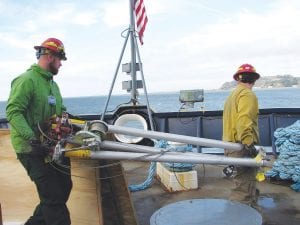Two members of the Grand Portage Band of Lake Superior Chippewa’s emergency response crew—Cory Hahn and Chris Skildum—traveled to San Francisco Bay in California to participate in testing new rapid response tools for combatting invasive species. Hahn and Skildum are pictured here setting up the testing equipment on the Golden Bear.

Two members of the Grand Portage Band of Lake Superior Chippewa’s emergency response crew traveled to San Francisco Bay in California to participate in testing new rapid response tools for combatting invasive species.
The trials are being conducted on the California Maritime Academy training ship Golden Bear, a U.S. Coast Guard ballast treatment system test facility. The trials will provide efficacy results of a portable ballast water treatment system (BWTS) that is designed to reduce live aquatic invasive species in ballast tanks.
Ballast water discharges from ships (water used for ship stability in the absence of cargo) are a primary pathway for introduction of invasive species. U.S. federal regulations require installation of permanent BWTS, but full compliance for all ships entering U.S. waters will take years to complete. The mobile BWTS being tested in California could serve as an interim solution and into the future as a contingency measure to address mechanical failures. Such failures are likely since new treatment technologies are operating in difficult operating environments on a wide variety of ships
The Grand Portage Band has worked cooperatively with the National Park Service since 2008, first in planning for response to the threat of the fish disease Viral Hemorrhagic Septicemia (VHS) and most recently providing a crew to support rapid response ballast treatment trials in California.
While the two Grand Portage emergency crewmembers, Cory Hahn and Chris Skildum, have deployed to many natural disasters together, this trip is focused on preventing a disaster in the future, rather than responding to a current emergency.
Hahn commented, “I saw this as both a learning opportunity and a chance to help band members protect an important resource— their fisheries. Last time we were in California was fighting fires, so this is a welcome change of pace.”
The two crew members were selected for their emergency response experience and familiarity with the small engines and pumps used in the BWTS.
A mobile treatment system is also intended for use in vessel groundings that could require ballast discharge to lighten the ship to free it. Such discharges tend to occur in shallow water areas more likely to have suitable habitat for aquatic invasive species.
A grounding occurred in 1994 in Biscayne National Park and NPS required treatment of the ballast water followed by neutralization of the biocide prior to discharge. Emergency treatment was also implemented on the NPS passenger vessel Ranger III in 2007 to prevent introduction of VHS at Isle Royale National Park.
After testing is completed in California, the crew and the equipment will return to the Midwest and be available for further deployment for saltwater applications or to help document efficacy under freshwater conditions.
Phyllis Green, NPS coordinator and Isle Royale National Park Superintendent, stated, “We are optimistic that we will achieve significant kill rates of organisms in ballast water with this equipment. We aim to make the process and equipment available to federal, state and local governments and industry who want to partner with us to develop a demonstration project in the Great Lakes either as part of a rapid response exercise or as an intervention on high risk saltwater ships entering the Great Lakes.”


Loading Comments